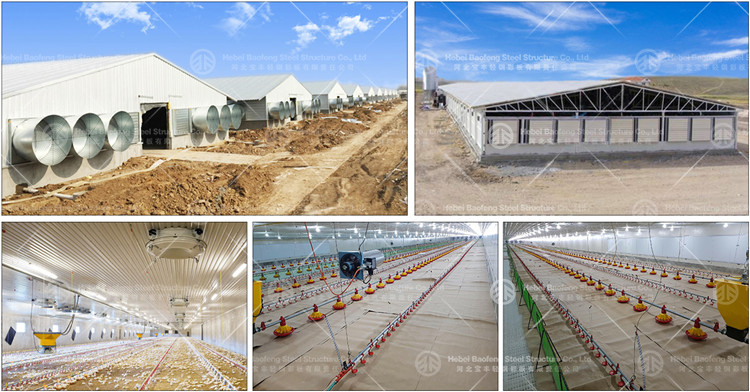
Why Choose Steel Structure for Livestock Raise?
Choosing steel structures for livestock raising (like barns, poultry houses, dairy facilities, and equestrian arenas) has become increasingly popular due to a combination of durability, efficiency, and long-term economic benefits.
Here’s a detailed breakdown of why steel is an excellent choice for livestock buildings.
Key Advantages of Steel Structures for Livestock
1. Superior Durability and Longevity
Resistance to Elements: Steel is impervious to many threats that destroy traditional wood buildings. It will not rot, warp, crack, or split. It is also resistant to damage from pests like termites and rodents that can burrow into wooden walls.
Weather Resistance: Properly engineered and coated steel buildings can withstand heavy snow loads, high winds, and seismic activity much better than many other materials. Galvalume or galvanized coatings provide excellent resistance to corrosion, which is crucial in the moist, ammonia-rich environment of animal housing.
Long Lifespan: A well-maintained steel livestock building can last for decades, significantly outlasting wooden structures that require constant repair and replacement.
2. Low Maintenance and Cost-Effectiveness
This is one of the biggest selling points. Steel structures require minimal upkeep.
No Painting or Treating: Unlike wood, steel doesn’t need to be painted regularly or treated for pests. Occasional cleaning is usually sufficient.
Reduced Repair Costs: There are no broken boards to replace or rotting posts to repair. This translates to significant savings in both time and money over the life of the building.
3. Design Flexibility and Spacious Interiors
Clear-Span Interiors: Steel buildings can be designed with clear-span interiors, meaning there are no support columns or load-bearing walls. This creates a wide-open, unobstructed space that is ideal for:
Housing large numbers of animals efficiently.
Maneuvering feeding equipment, tractors, and cleaning machinery.
Designing flexible pen and stall layouts that can be easily reconfigured as needs change.
Easily Expandable: If your operation grows, steel structures can be relatively easily extended by adding more bays to the existing frame.
4. Faster and More Efficient Construction
Prefabricated Components: Steel buildings are typically pre-engineered and prefabricated off-site. The components arrive ready to be assembled, like a large kit.
Reduced Labor Time: This precision manufacturing leads to a much faster and more straightforward construction process compared to traditional stick-building, which reduces labor costs and gets your operation up and running sooner.
5. Improved Hygiene and Animal Health
Smooth, Non-Porous Surfaces: Steel walls and liners are smooth and do not absorb moisture, manure, or bacteria. This makes them much easier to sanitize and disinfect between herds or flocks, helping to control the spread of disease.
Better Ventilation Control: The design flexibility of steel structures allows for the optimal placement of ventilation systems (ridge vents, side curtains, fans). Proper airflow is critical for removing moisture, ammonia, and heat, which directly improves animal health and productivity.
6. Fire Resistance
Steel is non-combustible. This is a major safety advantage in agricultural settings where electrical equipment, heating lamps, and stored hay can present fire hazards. A steel building will not contribute to the spread of a fire, potentially reducing insurance premiums and protecting your valuable livestock and equipment.
7. Environmental Sustainability
Recycled Content: Most structural steel is made with a high percentage of recycled material.
100% Recyclable: At the end of its incredibly long life, the entire steel building can be recycled, unlike wood frames which often end up in a landfill.
Energy Efficiency: Steel buildings can be easily insulated to a high standard, reducing the energy required for ventilation fans, heating, or cooling.
Considerations and Potential Challenges
To be balanced, it's important to address common concerns:
Condensation: This is the most frequently cited issue. In warm, humid barns, moisture can condense on cold steel panels. However, this is easily mitigated by proper insulation and ventilation design, which is a standard practice for quality builders.
Initial Cost: The upfront material cost for a steel building can be higher than a basic wood-frame structure. However, when you factor in the drastically lower maintenance costs, longer lifespan, and construction efficiency, the long-term cost of ownership is often lower.
Corrosion in High-Ammonia Environments: Ammonia from animal waste can accelerate corrosion. The solution is to specify the correct steel grade and protective coatings (paints) specifically designed for agricultural environments, ensuring longevity.

Categories
latest blog
Tags